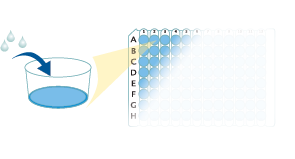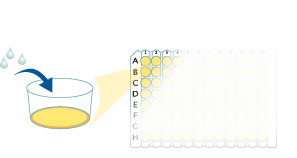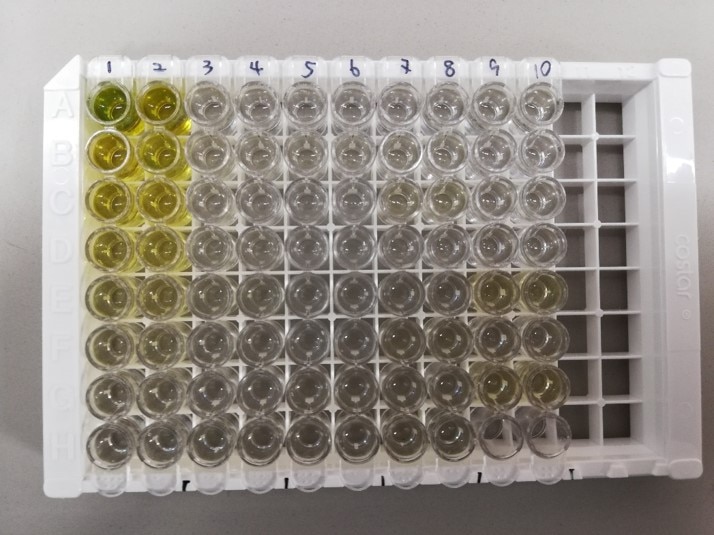Mouse LIF Quantikine ELISA Kit Summary
Product Summary
Recovery
The recovery of mouse LIF spiked to three levels throughout the range of the assay in various matrices was evaluated.
| Sample Type | Average % Recovery | Range % |
|---|---|---|
| Cell Culture Supernates (n=6) | 98 | 81-108 |
| EDTA Plasma (n=6) | 97 | 87-110 |
| Serum (n=5) | 96 | 90-108 |
Linearity
Scientific Data
Product Datasheets
Preparation and Storage
Background: LIF
Based on its helical structure, LIF (Leukemia Inhibitory Factor) is considered a member of the Interleukin-6 family of cytokines. Functionally, it has been implicated in a many physiological processes including development, hematopoiesis, bone metabolism, and inflammation. Some cell types known to express LIF include activated T cells, monocytes, astrocytes, osteoblasts, keratinocytes, regenerating skeletal muscle, mast cells, and fibroblasts. The activities of LIF are mediated through a high-affinity heterodimeric receptor complex consisting of two membrane glycoproteins: an alpha subunit (LIF R alpha, also known as LIF R beta and CD118) that binds LIF with low affinity and the 130 kDa (gp130) subunit that does not bind LIF by itself, but is required for high-affinity binding of LIF by the complex.
Assay Procedure
Refer to the product- Prepare all reagents, standard dilutions, and samples as directed in the product insert.
- Remove excess microplate strips from the plate frame, return them to the foil pouch containing the desiccant pack, and reseal.
- Add 50 µL of Assay Diluent to each well.
- Add 50 µL of Standard, Control, or sample to each well. Cover with a plate sealer, and incubate at room temperature for 2 hours.
- Aspirate each well and wash, repeating the process 4 times for a total of 5 washes.
- Add 100 µL of Conjugate to each well. Cover with a new plate sealer, and incubate at room temperature for 2 hours.
- Aspirate and wash 5 times.
- Add 100 µL Substrate Solution to each well. Incubate at room temperature for 30 minutes. PROTECT FROM LIGHT.
- Add 100 µL of Stop Solution to each well. Read at 450 nm within 30 minutes. Set wavelength correction to 540 nm or 570 nm.





Citations for Mouse LIF Quantikine ELISA Kit
R&D Systems personnel manually curate a database that contains references using R&D Systems products. The data collected includes not only links to publications in PubMed, but also provides information about sample types, species, and experimental conditions.
15
Citations: Showing 1 - 10
Filter your results:
Filter by:
-
IL-6 is dispensable for causing cachexia in the colon carcinoma 26 model
Authors: Kwon, YY;Hui, S;
bioRxiv : the preprint server for biology
Species: Mouse
Sample Types: Plasma
-
Leukemia inhibitory factor is a therapeutic target for renal interstitial fibrosis
Authors: S Xu, X Yang, Q Chen, Z Liu, Y Chen, X Yao, A Xiao, J Tian, L Xie, M Zhou, Z Hu, F Zhu, X Xu, F Hou, J Nie
EBioMedicine, 2022-11-04;86(0):104312.
Species: Mouse
Sample Types: Tissue Homogenates
-
LIF, a mitogen for choroidal endothelial cells, protects the choriocapillaris: implications for prevention of geographic atrophy
Authors: P Li, Q Li, N Biswas, H Xin, T Diemer, L Liu, L Perez Guti, G Paternostr, C Piermarocc, S Domanskyi, RK Wang, N Ferrara
Embo Molecular Medicine, 2021-11-15;0(0):e14511.
Species: Bovine, Mouse
Sample Types: Cell Culture Supernates
-
KAI1(CD82) is a key molecule to control angiogenesis and switch angiogenic milieu to quiescent state
Authors: JW Lee, J Hur, YW Kwon, CW Chae, JI Choi, I Hwang, JY Yun, JA Kang, YE Choi, YH Kim, SE Lee, C Lee, DH Jo, H Seok, BS Cho, SH Baek, HS Kim
Journal of hematology & oncology, 2021-09-16;14(1):148.
Species: Mouse
Sample Types: Cell Culture Supernates
-
Astrocyte-Derived Estrogen Regulates Reactive Astrogliosis and is Neuroprotective Following Ischemic Brain Injury
Authors: J Wang, GR Sareddy, Y Lu, UP Pratap, F Tang, KM Greene, PL Meyre, RR Tekmal, RK Vadlamudi, DW Brann
J Neurosci, 2020-11-06;0(0):.
Species: Mouse
Sample Types: Tissue Lysates
-
Targeting a therapeutic LIF transgene to muscle via the immune system ameliorates muscular dystrophy
Authors: SS Welc, I Flores, M Wehling-He, J Ramos, Y Wang, C Bertoni, JG Tidball
Nat Commun, 2019-06-26;10(1):2788.
Species: Mouse, Transgenic Mouse
Sample Types: Serum
-
Different murine-derived feeder cells alter the definitive endoderm differentiation of human induced pluripotent stem cells
Authors: M Shoji, H Minato, S Ogaki, M Seki, Y Suzuki, S Kume, T Kuzuhara
PLoS ONE, 2018-07-26;13(7):e0201239.
Species: Mouse
Sample Types: Cell Culture Supernates
-
Leukemia Inhibitory Factor Enhances Endogenous Cardiomyocyte Regeneration after Myocardial Infarction
PLoS ONE, 2016-05-26;11(5):e0156562.
Species: Mouse
Sample Types: Plasma
-
Cardiac fibroblasts mediate IL-17A-driven inflammatory dilated cardiomyopathy.
Authors: Wu L, Ong S, Talor M, Barin J, Baldeviano G, Kass D, Bedja D, Zhang H, Sheikh A, Margolick J, Iwakura Y, Rose N, Cihakova D
J Exp Med, 2014-06-16;211(7):1449-64.
Species: Mouse
Sample Types: Cell Culture Supernates
-
Improving embryonic stem cell expansion through the combination of perfusion and Bioprocess model design.
Authors: Yeo D, Kiparissides A, Cha J, Aguilar-Gallardo C, Polak J, Tsiridis E, Pistikopoulos E, Mantalaris A
PLoS ONE, 2013-12-10;8(12):e81728.
Species: Mouse
Sample Types: Cell Culture Supernates
-
Leukemia inhibitory factor signaling is required for lung protection during pneumonia.
Authors: Quinton LJ, Mizgerd JP, Hilliard KL
J. Immunol., 2012-05-11;188(12):6300-8.
Species: Mouse
Sample Types: BALF
-
Blocking LIF action in the uterus by using a PEGylated antagonist prevents implantation: a nonhormonal contraceptive strategy.
Authors: White CA, Zhang JG, Salamonsen LA, Baca M, Fairlie WD, Metcalf D, Nicola NA, Robb L, Dimitriadis E
Proc. Natl. Acad. Sci. U.S.A., 2007-11-27;104(49):19357-62.
Species: Mouse
Sample Types: Serum
-
Astrocytes promote myelination in response to electrical impulses.
Authors: Ishibashi T, Dakin KA, Stevens B, Lee PR, Kozlov SV, Stewart CL, Fields RD
Neuron, 2006-03-16;49(6):823-32.
Species: Mouse
Sample Types: Cell Culture Supernates
-
Leukemia inhibitory factor is linked to regulatory transplantation tolerance.
Authors: Metcalfe SM, Watson TJ, Shurey S, Adams E, Green CJ
Transplantation, 2005-03-27;79(6):726-30.
Species: Mouse
Sample Types: Cell Culture Supernates
-
Leukaemia inhibitory factor (LIF) is functionally linked to axotrophin and both LIF and axotrophin are linked to regulatory immune tolerance.
Authors: Metcalfe SM, Muthukumarana PA, Thompson HL, Haendel MA, Lyons GE
FEBS Lett., 2005-01-31;579(3):609-14.
Species: Mouse
Sample Types: Cell Culture Supernates
FAQs
No product specific FAQs exist for this product, however you may
View all ELISA FAQsReviews for Mouse LIF Quantikine ELISA Kit
Average Rating: 4.8 (Based on 4 Reviews)
Have you used Mouse LIF Quantikine ELISA Kit?
Submit a review and receive an Amazon gift card.
$25/€18/£15/$25CAN/¥75 Yuan/¥2500 Yen for a review with an image
$10/€7/£6/$10 CAD/¥70 Yuan/¥1110 Yen for a review without an image
Filter by:








